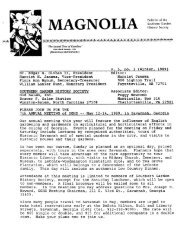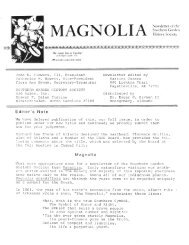Vol. XII, no. 2, 3 & 4 - Southern Garden History Society
Vol. XII, no. 2, 3 & 4 - Southern Garden History Society
Vol. XII, no. 2, 3 & 4 - Southern Garden History Society
You also want an ePaper? Increase the reach of your titles
YUMPU automatically turns print PDFs into web optimized ePapers that Google loves.
the eighteenth-century . A crape myrtle was<br />
also recorded . Crape myrtle was introduced<br />
into Europe in 1759 and grown by George<br />
Washington by 1799 [as well as by Lady Jean<br />
Skipwith]. A<strong>no</strong>ther important plant is a<br />
crabapple, which needs further identification and<br />
research .<br />
Some plants on site, although appropriate to the<br />
eighteenth century, were planted more recently,<br />
such as the Rose of Sharon along the <strong>no</strong>rth fence .<br />
Albert Cowles remembers when it was small and<br />
newly planted. Other plants raise questions. The<br />
large stand of Phragmites communis, also called<br />
Arundo donax, in the back of the garden is a n<br />
ornamental grass often found on nineteenth –<br />
century sites. It was introduced from the Caribbean ,<br />
however, and with Tucker's ties to Bermuda ,<br />
speculation was raised whether he brought the plant<br />
into the area. Unfortunately, to date <strong>no</strong> information<br />
has been found to confirm this theory . Shurcliff als o<br />
failed to <strong>no</strong>te anything other than a border bed in<br />
that area .<br />
Research continues on several other plants to<br />
determine their importance in the landscape <strong>no</strong>rt h<br />
of the house . Several iris species occur there, for<br />
example . Iris germanica grows under a large pecan ,<br />
I. anglica [I. xiphiodes] or I. spuria follow the west<br />
side of the main central path and a tentatively<br />
identified I. camphori rings a fish pond or catch<br />
basin. An unidentified Allium, which is <strong>no</strong>t th e<br />
Yorktown onion (Allium ampeloprasum), follow s<br />
the east side of the central path near the hollyhock .<br />
A viburnum and a hawthorne dot the lawn behin d<br />
the kitchen. In what appears to be an overgrow n<br />
planting bed next to a walkway, two rudbeckia s<br />
and an number of Jamestown lilies (Zephyranthes<br />
atamasco) remain .<br />
Some plants that still remain on the property<br />
can definitely be linked to Shurcliffs plans an d<br />
plantings. The peonies occur at the intersections of<br />
the cross–paths on the western half of the formal<br />
garden. Some were removed in 1992–93 . The<br />
hollyhock showed up in a photograph of new<br />
plantings in the 1930s. Three colors exist side b y<br />
side: a dark rose, a lavender, and a white one . A<br />
clump of `Daisy Schaffer' daffodils (1927) fits exactly<br />
at the corner of Shurcliffs western geometric pla n<br />
and is <strong>no</strong>t related to any <strong>no</strong>ted previous plantings . I t<br />
was probably planted by Shurcliff or moved fro m<br />
a<strong>no</strong>ther area of the garden in the 1930s. Severa l<br />
narcissus have newer dates of introduction, which<br />
eliminate them as candidates for extensive study<br />
relating to Tucker's garden but do document<br />
continuing gardening activity on the property .<br />
`Trousseau' dates to 1934, `Yellow<br />
Cheerfulness' to 1938, and `Flower Drift', a<br />
double–flowering sport of `Flower Record '<br />
that occurred in 1966 .<br />
The front yard contains some plants that are<br />
appropriate for an eighteenth–century landscape<br />
such as the pyracantha and Spanish bluebells at th e<br />
base of the chimney, the lilac and pussy willow and<br />
Vinca mi<strong>no</strong>r in front of the kitchen, and the<br />
star–of–Bethlehem near the front steps . Coral vin e<br />
(Lonicera sempervirens) and autumn crocus<br />
(Colchicum autumnale) run along the front fence .<br />
Because this area is more public, it seems to hav e<br />
had the most recent gardening activity . Therefore, it<br />
is uncertain at this time whether any of these plants ,<br />
including those appropriate to the eighteent h<br />
century, are much older than a few decades . Severa l<br />
clumps of narcissus suggest older plantings such a s<br />
along the front fence where `Dick Wellband' (1929)<br />
and `Mary Copeland' (1914) bloomed . Along the<br />
front entrance walk, clumps of `Twink' (1927) an d<br />
`Empress' (1890) blossomed, both of which are <strong>no</strong><br />
longer in commerce . It must be stressed, however ,<br />
that all of these flowers could also have bee n<br />
moved. The forsythia <strong>no</strong>rth of the garage and th e<br />
one on the <strong>no</strong>rthwest corner of the kitchen coul d<br />
<strong>no</strong>t have been planted before the mid–nineteenth<br />
century. Likewise, the double azalea and the<br />
modern daylily cultivars, both single and double,<br />
suggest a continued interest in gardening by th e<br />
family, perhaps passed down through the<br />
generations. When the enlarged parking area was<br />
installed for Dr. Kimbrough, hostas were planted<br />
around the perimeter . Maintaining an attractive<br />
landscape seems to have been a priority for Tucker<br />
and his descendants. Whether or <strong>no</strong>t they shared his<br />
enthusiasm for gardening we may never k<strong>no</strong>w bu t<br />
hopefully with more research, we can understand<br />
the numerous changes of the landscape since 1788 .<br />
Because the older bulb varieties demonstrate the<br />
gardening history of the property in ways <strong>no</strong>thin g<br />
else can, it is hoped they will remain on the site an d<br />
be incorporated into the new garden plans i f<br />
possible. Many of these early cultivars are <strong>no</strong> longe r<br />
available commercially, and therefore are themselves<br />
of historical importance . At the very least ,<br />
their yearly re–emergence from where they were<br />
buried long ago serves to remind us of the<br />
numerous changes a landscape undergoes through<br />
time, whether by nature or design +<br />
8
















